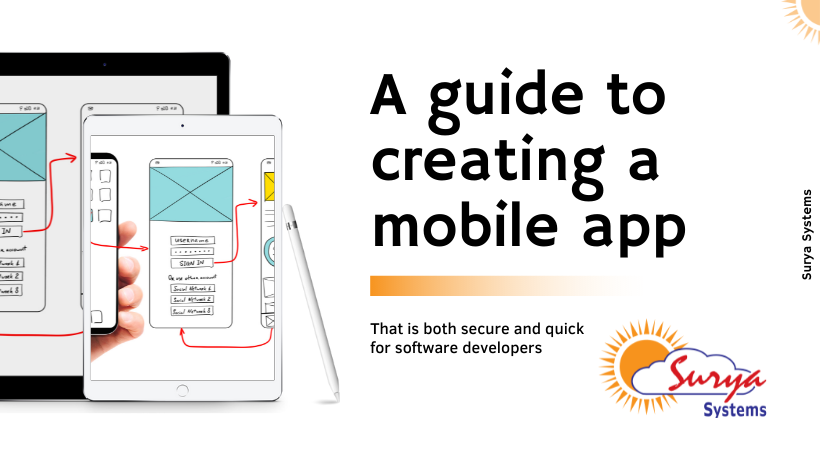- December 9, 2021
- Posted by: Sean Cooper
- Category: Technical Expertise

Mobile App Development:
Mobile app development is booming, but they need to develop secure, fast mobile apps for organizations to succeed.
In the digital age, mobile apps present enormous opportunities for businesses. Statista predicts that international mobile application sales will reach US$935 billion in 2023, up from US$365 billion last year.
Mobile app development, however, differs significantly from enterprise software development. A mobile app is usually cloud-native, compatible with various devices and operating systems, and is built using microservices running on Android or iOS.
On the other hand, software developers are frequently under pressure to develop mobile apps quickly and securely. Can they do these things while taking into account the unique requirements of mobile apps?
Today, businesses across all industries rely on mobile apps. When these apps are made vulnerable to security problems and then breached by cybercriminals, companies could suffer significant disruptions to their daily operations.
“The mobile app is as important as any other part of your business. Harder-to-spot security breaches could have disastrous consequences,” Olexandr Leuschenko from Ciklum, head of mobile.
Security is often underrated in mobile app development, and engineering teams rely on Apple and Google’s standard levels of protection. In reality, however, it is the developers’ responsibility to secure the apps they are building.
Leuschenko believes that software developers should secure mobile apps from the beginning. Specifically, he recommends that developers integrate security assessments into the software development lifecycle, follow established security principles, and use solutions with proven efficiency.
According to him, developers should follow the most basic security measures, such as obscuring the code, disabling JavaScript in web views unless required, not storing sensitive information in plain text, and not committing anything sensitive to the VCS [version control system].
Jake Moore, an ESET security specialist, supports this view. He says that developers can extend protection by ensuring app functions are secure at the beginning of development. He admits that it is hard to improve security for mobile apps due to the number of operating systems and platforms available.
Moore also points out that developers can have problems with mobile app security due to the rapid aging of phone hardware. He explains that multifactor authentication is one way to protect account holders against rogue access on all platforms, regardless of whether they are using a smartphone or tablet.
Developers must also safeguard user data when creating mobile apps, says Moore. In Moore’s view, data stored within a program should be protected to ensure that only authorized users have access to it.
“Encryption is a way to limit unauthorized access to data and can easily be integrated into an app, regardless of its generation. App developers are not responsible for the protection of any data stored in the cloud.”.
Moore states that testing is an integral part of mobile app development. However, he warns that this can be difficult for developers when dealing with multiple operating systems and hardware versions.
“Zero-trust security is also a solid security method whereby it assumes that nothing on a network is secure,” he says. “The smallest number of permissions is granted to users or machines, and only as necessary, protecting the network.”
Reacting to the changing needs of the user:
According to Amit Sharma (security engineer at Synopsys Software Integrity Group), mobile app development requirements have changed drastically due to different user needs. He says that the development community focuses on native libraries that can help them streamline their work to adapt to the changing mobile ecosystem.
“Automation is key to meeting the needs of the market. This is possible thanks to the use of native cloud technologies. Developers can launch and test apps simultaneously on multiple platforms. This allows for greater reliability and scalability. Rapid software development and deployment are essential.”
Sharma believes that organizations must ensure security integration from the beginning of mobile app development. Sharma recommends that developers be educated about secure coding guidelines and encourage them to test the code at all stages of development.
He says that there should be checks on the inherent risk of any application due to the widespread use of the third-party library in the mobile domain. Regular scans to check for third-party library risks and license obligations are a must and the compliance procedures across operating systems and platforms.
According to Sharma, application programming interfaces (APIs), which facilitate back-end communication, pose a security challenge that should be evaluated from a security standpoint. Data should also be protected using appropriate cryptographic mechanisms both at rest and in transit, he says. It is crucial to review permissions that contribute to zero trust to develop secure apps. Awareness is the key to security.
Developing mobile apps with reduced security burdens:
Developing Apps to support multiple operating systems and devices is an arduous task, says Sean Wright, application security lead at Immersive Labs. Nevertheless, he points out that newer mobile app development frameworks, such as Cordova, can help ease this burden.
“The framework abstracts most of this difficulty,” he says. “This allows developers to maintain only one application in terms of source code. However, keeping this framework up-to-date is crucial to making sure that the application is kept secure.”
As Wright points out, Android and iOS have come a long way in ensuring that developers create secure applications. TLS [transport layer security] is a good example, he says. “Later versions of both mobile operating systems support a large amount of complexity, including certificate validation, which helps provide a more secure experience.”
Wright says developing secure mobile apps doesn’t differ significantly from developing web-based applications. You still need to follow best practices, such as encryption at rest and in transit, and use appropriate libraries and frameworks where applicable, as well as carry out security testing on released versions of mobile applications,” he says. Interestingly, mobile applications and web applications are pretty similar. Both use APIs to access data and process it.
Implementing a secure mobile app development process:
1Password developers view security and privacy as fundamental aspects of app development. “They determine how we design our apps, which features we implement, and how we implement them,” states Michael Verde, Android development team lead at 1Password.
1Password uses multiple encryption layers to protect communication with its server using its security-in-depth approach. “We use similar layers of protection in our apps by leveraging the security features of the platforms on which they run, such as encryption, sandboxing, and trusted execution environments,” he explains. “Our apps are built in layers, ensuring that the innermost layers only handle sensitive information.”
1Password’s mobile app development process is secure because it uses simple, easy-to-understand, and arduous to misuse features. Verde says that security is always in balance with convenience.
We use a standard base code to build our apps. This ensures that all sensitive paths in our code are secure and consistent across every app. This code is centralized to prevent common pitfalls such as logging sensitive data and personally identifiable information. Additionally, our security team and their security team can quickly check any changes made.
Businesses must ensure that mobile apps are safe and secure so that hackers cannot access them. They also need to quickly release apps to satisfy customers and keep up with the competition. Len Welter is the global product manager of the Bloomberg Professional mobile application.
He says that we have invested heavily in our mobile platforms and infrastructure over the past several years with the specific goal of speeding the development of the Bloomberg Professional app. This has been done without compromising performance or the native iOS/Android user experience.
Bloomberg can release app updates quickly using its own mobile software development kit (SDK), says Welter. Welter claims that the Mobile SDK is a small collection of well-tested, performant, and reusable components that run natively on iOS and Android. Using this method, the user interface and the underlying business logic can remain consistent regardless of changes in the business requirements.
“We are now able to update our app to meet client demand quickly. The Mobile SDK allowed us to promptly update our app to meet client demand in just days or weeks. It also enabled us to deliver complex functionality to both iOS AND Android in a matter of days or weeks.
Many businesses are now embracing mobile apps. Mobile app development is complex and requires developers to be able to comprehend the many factors involved. Mobile apps need to be secured and distributed as quickly as possible. Mobile app development success requires these prerequisites.
https://www.suryasys.com/is-data-analytics-the-same-as-data-science/
